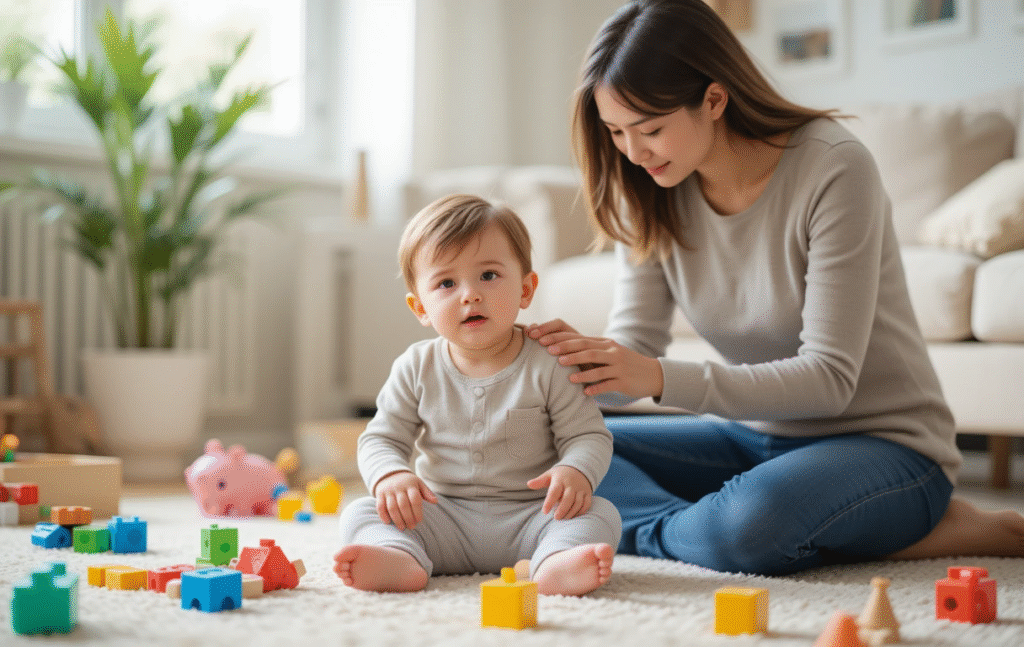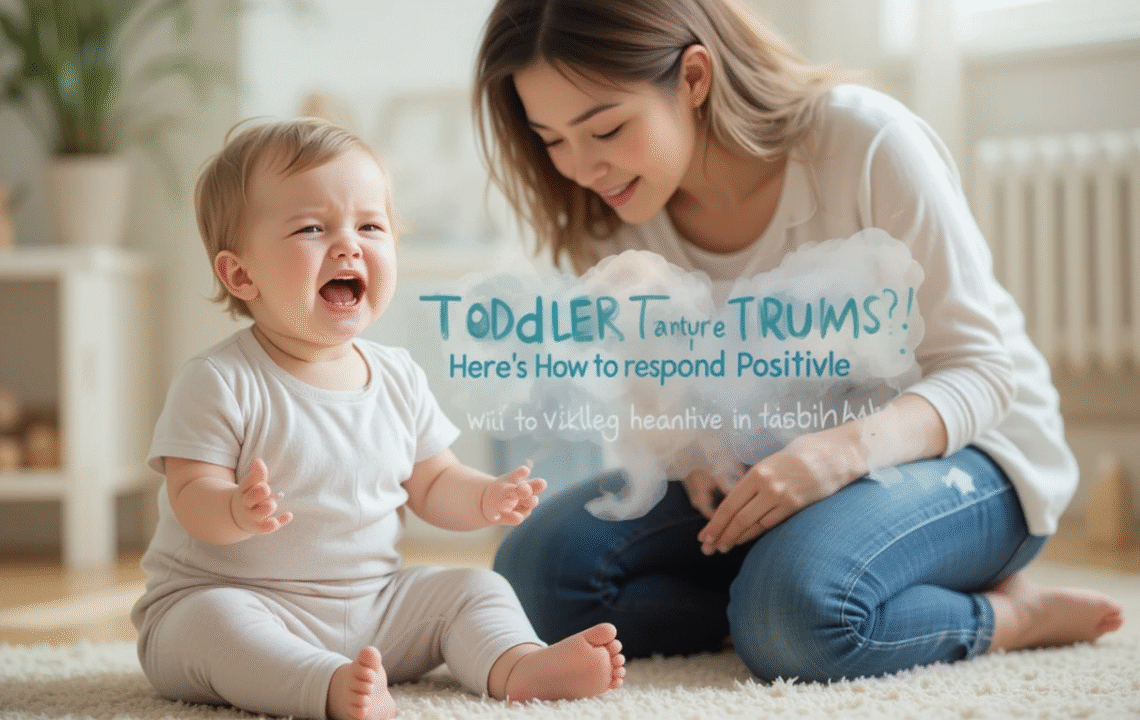No matter how many people have tried to tell me, I’ll be honest. No one prepares you for when your toddler plants himself on your kitchen floor in a complete tantrum over the wrong cup.
If you’re a parent, you’ve been there. The red cup catastrophe, the sock that isn’t “right,” or deciding abruptly that the sandwich has been cut the “wrong way.” It’s chaos. It’s also totally normal.

Toddler tantrums are not evidence that something is wrong with your parenting. In truth, they’re a sign your tiny human is learning to handle big feelings. The secret? Responding to those moments with patience, consistency, and love.
Let’s explore five positive parenting strategies without yelling, bribing, or caving in.
- Get Inside the Mind of Your Toddler’s Tantrums.
Before we fix it, we need to understand what’s going on.
Emotional regulation is a skill toddlers are still learning. Their brains are not wired (yet) to sit back and reflect or express what they want in a calm voice. So, they explode when they’re tired, hungry, overstimulated—or all three .
Rather than thinking of the tantrum as bad behavior, try thinking of it as communication. Your toddler isn’t being demanding — they’re having a difficult time.
This change in mindset makes all the difference.
Real-life example:
We were recently at a coffee shop when my 3-year-old lost it over a wrong—sized banana muffin. I was embarrassed. But instead of snapping, I crouched down to his eye line and said, “You wanted the other muffin. That’s hard, huh?” And as if on cue, he melted.
Empathy doesn’t make a tantrum vanish immediately, but creates trust over time.
- Remaining Calm and Self-Regulating First
You fill in the last space. Positive parenting begins with you. Yep—hard truth. And if you’re yelling “STOP YELLING!” while hollering … you get the drift.
Your toddler is your emotional barometer. If you’re steady, it gives them a sense of security. If you’re dysregulated, it adds fuel to the fire.

So when a tantrum hits:
- Take a breath (or ten).
- Speak in a low, calm tone, but say nothing.
- Tell yourself: “They’re not giving me a hard time — they’re having a hard time.”
It’s not easy, particularly if you’re late and someone is flailing around on the floor in their pyjamas. But calm responses de-escalate the moment far more quickly than power struggles.
NHS Parenting Tips explains that “children who feel emotionally safe will be more willing to accept discipline and learn self-control.”
- Establish Gentle Boundaries
One of the greatest misconceptions about positive parenting is that it says “yes” to everything.
That’s not true. It’s about gently saying “no” and holding your ground without disrespect, punishment, or shame.
Example:
Not letting you throw that toy. It can hurt someone. You’re pissed and that’s just fine. Let’s figure out another way to let it out.”
This teaches toddlers that:
- Boundaries exist.
- Their feelings are valid.
- We can express big emotions in safe ways.
Consistency matters here. If you say no to chocolate before dinner, no means no—no matter how Oscar-worthy the tantrum is.
It may feel thankless now, but you will thank yourself in the future.
- Present to Choose from to Eliminate Power Struggles
Toddlers crave control. And why wouldn’t they? Their world is jam-packed with rules they never made. Which is why offering restricted, age-appropriate choices is a bit like magic.
Instead of: “Put on your shoes now!” Try: “Are you going to wear red or blue shoes?”
It gives your toddler a bit of independence, without enabling them to take over. It also reduces the chances of tantrums, as “You’re making me do this” shifts to ”I chose this.”
This technique applies to shoes, snacks, bath time, bedtime, and car seats (sometimes).

Little choices = big collaboration.
- Reconnect After the Storm
After the meltdown has ended, your toddler may be confused, embarrassed, or drained. That’s your moment to nurture reconnection.
Please pick them up. Offer a cuddle. Say something like:
“That was hard. But I’m here. I love you, even when you’re mad.”
Why does this matter?
It builds emotional security, that’s why. Your child is learning they won’t lose you, no matter how out of control they feel.
This is how we raise emotionally intelligent, self-aware children. We do not demand apologies or pretend that we never hurt or could be hurt or felt even momentarily slighted or stigmatized by something someone said or did, but by demonstrating for them what healing and resilience look like.
And, you know — this is an emotional intelligence lesson as well.
When to Say No (Even When It’s Tempting)
Let’s face it, there are days when you want to threaten, bribe, or walk out of the front door for some air. That’s okay. You’re human.
Yet here are some things fear thrives on you avoiding whenever you can:
- Shaming language (“You’re being such a baby!”).
- Empty threats (“I’m going to leave you here!”).
- Disciplining without teaching (“You sit here in a time-out because you’re crying!”)
- Over-rationalizing (It is impossible to process logic during a meltdown)
Instead, hold off until everybody is calm before talking or teaching.
Good Parenting Asks for Help
Let’s get this out of the way: Positive parenting doesn’t mean you will never lose your cool. It doesn’t mean your toddler will magically turn into a placid, rule-following helper overnight.
It means you:
- Opt for connection versus control.
- Focus on growing them in the long run, not making them obey in the short run.
- Consider behaviour to be an expression , not defiance.
You’ll mess up—we all do. The important thing is to fix, reconnect, and move forward.”
Real Talk: This Too Shall Pass (Tantrums)
You are not alone if your days are lentil-mindful and (loop “No! I don’t want to!” with a soundtrack of crying and yelling.
This is a season. It’s loud, random, and, hey, sometimes exhausting. But it’s also full of growth for you and your toddler.

Your little creature is learning to be a person. And you? You are the calm in their storm.
One meltdown at a time.
Want even more tools to help you stay grounded and present during tough moments? Check out 5 New and Epic Secrets for Calm Parenting Techniques — it’s full of real-world calm strategies.
Conclusion on Dealing with Toddler Tantrums
Tantrums are tough, but you’re stronger and far more competent than you realize. When you respond with empathy, offer choices, keep your cool, and reconnect afterward, you teach your toddler emotional skills that will last a lifetime.
You don’t need perfection. You need presence.
Tantrums are just one part of the parenting puzzle. If you want to explore more tools to help raise a calm, confident child, don’t miss our 5 Most Effective Positive Parenting Tips for Modern Families guide. It’s packed with simple, real-life strategies you can start today.
Want to be Better Prepared for Their Next Meltdown?
If this helped, please share with another parent or leave a comment. What’s one trick to keep your cool when your toddler is mid-tantrum?
Let’s be there for each other—have you heard this parenting thing? It’s not a simple task, but we’re doing it together.
Want to get parenting stories like this sent to your inbox? Sign up for Daily Lifestyle for weekly lifestyle news and tips.





